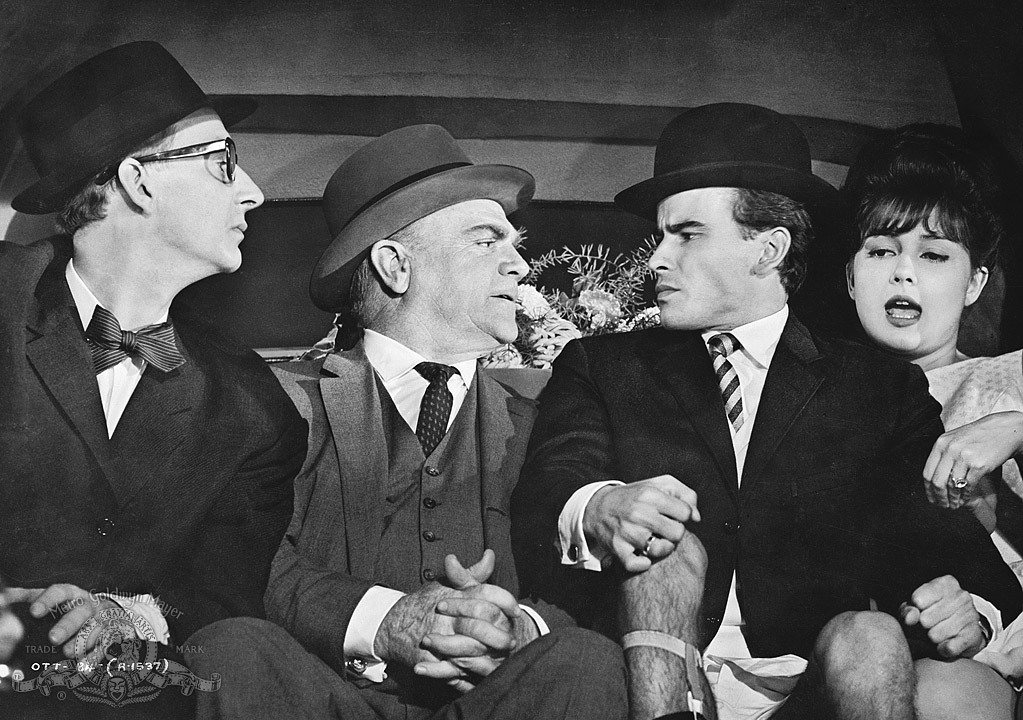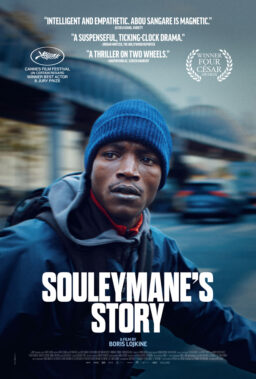Billy Wilder’s “One, Two, Three” relentlessly drives its plot and characters for a barrage of laughs and chuckles from the beginning to the end. James Cagney plays C.R. MacNamara, a high-ranking executive of the Coca-Cola company who has been not that happy about being stationed in West Berlin in 1961. Since his career took a downturn due to a disastrous fiasco in the Middle East several years ago, he has worked very hard to rise the corporate ladder again, and now he is supervising the production and sales of Coca-Cola in West Germany, but he is still not very content while eagerly waiting for any chance for the promotion to the head of Western European Coca-Cola Operations in London. To impress his boss and others at the Coca-Cola headquarters in Atlanta, he has been working on the possibility of expanding the market to Russia and, possibly, other countries behind the Iron Curtain, but, not so surprisingly, dealing with Russian officials turn out to be a little too tricky as both sides keep refusing to step back more for the final agreement.
However, to MacNamara’s disappointment, it turns out that his boss is not particularly interested in dealing with Russians as your average conservative Southern guy. Instead, he asks MacNamara to look after his lively but problematic adolescent daughter Scarlett (Pamela Tiffin), who has been bouncing around here and there in Europe since causing the latest headache for her parents. MacNamara’s wife Phyllis (Arlene Francis) is not so pleased to hear that they have to cancel a family vacation for taking care of Scarlett, but, what do you know, it does not take much time for her to be amused and charmed by the incorrigibly irrepressible personality of Scarlett, who can be regarded as a precursor to those hippie girls in the late 1960s.
While her stay in MacNamara’s house is eventually extended from two weeks to two months, it looks like MacNamara may finally get a chance for promotion as Scarlett seems to be having a really good time in Berlin without causing any trouble, but, of course, he belatedly comes to learn about what she has been doing behind her back. Several weeks ago, she met a hardcore communist lad named Otto Piffl (Horst Buchholz) in East Berlin, and they instantly got closer to each other. She does not have any problem with his staunch anti-American viewpoint (“Why, that ain’t anti-American, it’s anti-Yankee. And where I come from, everybody’s against the Yankees.”), and now they become a married couple ready to leave for Moscow (“They’ve assigned us a magnificent apartment, just a short walk from the bathroom!”).
Horrified by this unexpected revelation, MacNamara quickly embarks on taking care of this big problem because Scarlett’s parents will soon come to West Berlin to see their dear daughter. At first, it seems that all he has to do is push Otto away from Scarlett once and for all and then nullify their marriage, but, alas, the situation becomes increasingly complicated for him, and he soon finds himself juggling numerous things to get the situation under control. Besides Otto and Scarlett, he has to handle 1) a trio of Russian officials, 2) a German assistant who frequently annoys MacNamara for his old army habit, 3) a German secretary who is quite willing to do ‘overtime’ for MacNamara, and 4) a bunch of other figures who can be easily persuaded to do MacNamara’s bidding via the power of, yes, money.
Cheerfully throwing more craziness into MacNamara’s circumstance, the screenplay by Wilder and his co-writer I.A.L. Diamond, which was adapted from Ferenc Molnár’s 1929 Hungarian one-act play “Egy, kettő, három” with some clear influence from “Ninotchka” (1939), seldom stops, accelerating itself more and more, and its resulting comic intensity rivals that of those Hollywood classic screwball films in the 1930s such as Howard Hawks’ “Bringing Up Baby” (1938). As reflected by the instruction written on the front of their screenplay, Wilder and Diamond were pretty clear about what they wanted from the beginning: “This piece must be played molto furioso. Suggested speed: 110 miles an hour–on the curves–140 miles an hour in the straightaways.” To be frank with you, if you think the characters in David Fincher’s “The Social Network” (2010) talk too fast, your mind may be overloaded during the second half of the movie.
Like many of Wilder’s comedy films, the movie occasionally shows sardonic sides behind its broad comic moments. While generating some edgy laughs from the postwar Germany society still recovering from its dark, shameful past, it certainly makes fun of the ridiculous aspects of the Cold War, and there is even one particular moment foreshadowing that perilous international crisis which happened not long after the movie was released in 1961 (“We have trade agreement with Cuba: they send us cigars, we send them rockets.”). As a matter of fact, Wilder had to halt the shooting of the film in Berlin when the Berlin Wall went up on August 13th, 1961, and he and his crew had no choice but to move to Munich to complete the movie.
And the movie is also frankly cynical in case of depicting MacNamara’s capitalistic tactics, which surely remind us how venal and selfish we can be from time to time. Almost everyone in the film has their price, and MacNamara does not have any problem with that at all. Fully focused on that elusive chance of promotion, he is prepared to accomplish his emergency mission within a few remaining hours by any means necessary, and he never feels any compunction to push himself and others around him as hard as he can – except when he faces the possibility of losing what matters most in his life later in the story.
Nevertheless, it is really fun to watch him trying to do his best in the name of survival and success, and we never get bored as the movie briskly glides along its bumpy narrative full of silly caricature characters and ridiculous plot turns. As Aram Khachaturian’s “Sabre Dance” is frequently utilized in André Previn’s bouncy score, we come to brace ourselves more for crazier moments to come, and we are not so surprised when even Otto finds himself swept along with others by MacNamara’s scheme, which eventually leads to quite an ironic outcome around the finale.
Above all, the movie depends a lot on Cagney’s presence and talent. Watching him busily handling them on the screen is akin to beholding a virtuoso precariously playing at the extreme end of his talent. Although he was understandably reluctant to take the role at first, Cagney, who was 62 years old when the movie came out, threw himself into his role as much as he did in “Yankee Doodle Dandy” (1942), and it is often spellbinding to see him deftly handling a number of talky scenes in the film while never losing control or speed at all. As a matter of fact, it is no wonder that he subsequently retired from acting for next 20 years until he appeared in Milos Forman’s “Ragtime” (1981), which was the last theatrical film in his long, distinguished acting career.
Cagney is surrounded by several colorful supporting performers also willingly going for big laughs whenever they get chance. While Pamela Tiffin is hilariously naïve and superficial in her supporting role, Arlene Francis is wryly acerbic as MacNamara’s no-nonsense wife, and Liselotte Pulver has a terrific showstopper moment when her character joyously performs a sort of striptease for those Russian officials in the middle of the movie. In case of Horst Buchholz, he is the weakest link in the film due to his rather strained performance, but his abrasive attitude clashes well with Cagney’s forceful persona on the screen, and you may be amused to learn that Cagney disliked Buchholz so much on the set that he often felt urged to “knock him on his ass”.
Although it is relatively less stellar compared to the comic perfection of “Some Like It Hot” (1959) or the bittersweet sublimity of “The Apartment” (1960), “One, Two, Three” is one of Wilder’s finest works thanks to its sheer farcical ferocity fueled by Cagney’s vigorously committed performance, and I dare to say that it is far more exciting and memorable than whatever I saw from those recent big blockbuster action flicks such as, say, “The Fast and The Furious” (2001) and its disposable sequels. Just watch how Cagney and the movie run at full speed together, and you will see what I mean.











